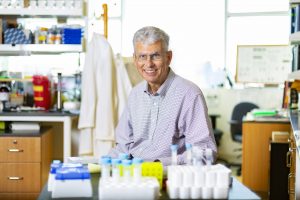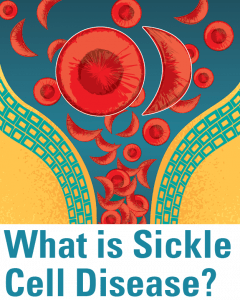Danielle Jamison’s blood turned on her. Now, an OMRF drug is giving her relief.
Danielle Jamison was just a few months old when her parents realized something was wrong. All babies cry, but this was different. The incessant wailing was the first clue, her father tells her, but then he noticed her small body had begun to swell. “I was a chunky baby, but this was a lot more than normal,” Danielle, now 36, says. “I have to commend my parents for not letting it go.”
The Jamisons wrapped up their inconsolable child and rushed her to the best hospital available, an hour and a half away from their home in rural South Carolina. After a battery of tests, they learned their daughter had sickle cell disease, a rare, life-threatening genetic disorder that causes ongoing damage to blood vessels and organs.

“I count it as a blessing that we found out early. A lot of people born at that time found out way later,” says Danielle, who has the most severe form of the disease, sickle cell anemia.
Because the condition stems from a chromosomal error passed from one generation to the next, Danielle’s diagnosis prompted her parents to test her older sister. Happily, they discovered she had only one copy of the defective gene, thus dodging the disease. But when Adrienne Jamison was born two years later, she was not so fortunate; she carries twin copies of the miswired chromosome and also has sickle cell anemia.
The Jamisons are two of an estimated 100,000 Americans living with sickle cell disease. Like Danielle and Adrienne, most are of African descent.
The condition occurs when the body makes an abnormal form of hemoglobin, which carries oxygen throughout the body. Normally pliable and round, red blood cells become rigid and sticky in the presence of this rogue hemoglobin, taking on the shape of a C or “sickle.” Instead of traveling smoothly through the bloodstream, they clump together in vessels, choking off blood supply to tissues and organs and causing long-term damage or even death.
The body responds to the problem by unleashing an arsenal of weapons to fight it. The extreme pain that results from the clustered cells, known as a crisis, can start anywhere in the body and last for weeks.
“You know what it is. It feels like you’re getting hit, over and over and over and over,” says Danielle. “And it never stops.”

Dr. Rodger McEver is a hematologist, a physician who specializes in blood disorders. In a scientific career that’s spanned five decades, his research has focused on blood cells.
As a medical student at the University of Chicago, McEver became fascinated with the abnormalities in blood cells that characterize many diseases. Peering at blood samples through a microscope, he wanted to know what caused these irregularities. When it came time for the young physician to choose a specialty, he picked hematology, the treatment and study of blood disorders. Since that time, his research in the laboratory has centered on blood cells.
In 1984, McEver led a team that discovered a protein now known as P-selectin. After joining OMRF three years later, McEver’s lab uncovered P-selectin’s function; namely, that it mobilizes white blood cells to hunt down and stop invaders such as bacteria in the body.
“Other investigators found that in laboratory mice engineered to develop a condition like sickle cell disease, P-selectin worsened symptoms,” says McEver. That protein, McEver came to believe, might hold a key to unlocking new therapies for the illness.
As a physician, he understood the toll sickle cell exacted on the body. “I’ve treated patients with the disease, and their suffering is extreme,” says McEver, who now serves as OMRF’s vice president of research.
In time, McEver and his OMRF team developed an antibody that disabled P-selectin’s effects. But he recognized the odds were long that his work would produce a treatment: The Pharmaceutical Research and Manufacturers of America estimates that only one in 5,000 compounds that begin preclinical testing prove safe and effective enough to reach pharmacies, clinics and hospitals. Still, he believed in the research and saw an opportunity to bring relief to people who were suffering. “It’s the dream of every physician, and certainly every scientist, to do something that can make a difference for patients.”
McEver helped create Selexys, an Oklahoma-based biotechnology company, to explore P-selectin’s therapeutic potential. Selexys struggled for several years, pursuing scientific paths that proved to be blind alleys. But when McEver eventually recruited two former OMRF graduate research students to lead the company, everything changed.
Drs. Scott Rollins and Russell Rother left Oklahoma in the early 1990s to join Alexion Pharmaceuticals, a start-up company formed around another OMRF discovery. The pair helped transform the finding into an experimental drug, then shepherded it through development and clinical trials. In 2007, that medication, Soliris, became the first drug approved by the U.S. Food and Drug Administration to treat a rare blood disorder known as PNH.
Upon the successful launch of Soliris, Alexion completed its evolution from scrappy upstart into one of the world’s biotechnology leaders. Rollins and Rother had played key roles in the company’s rise, but with the completion of the Soliris project, both saw a chance to return to their Oklahoma roots and to launch a new drug development project. When they came home – Rollins in 2008, Rother two years later – each joined Selexys.
With the pair at the helm, Selexys fine-tuned the antibody McEver had developed at OMRF, creating an experimental drug that bound to human P-selectin and blocked its function. In early-stage clinical trials, the treatment was shown to be safe and well tolerated. But the real test came in Phase II, where nearly 200 patients with sickle cell received the drug intravenously every four weeks for a year.
At the conclusion of the trial, the data showed nearly half of the patients had experienced a decrease in pain crises. When he saw the results, McEver “was so happy, but, honestly, I didn’t know how to react.” Rother, a biotech industry veteran, did. “We knew immediately that this was a home run.” How does a discovery become a drug? Follow the path to patients >>
So did Swiss drugmaker Novartis, which had been an investor in Selexys. It purchased the company and, with it, the drug that would come to be known as Adakveo. The Phase II results proved so convincing that Novartis bypassed the final stage of clinical trials and went directly to the FDA for approval, which the agency granted in November of 2019.

These clogs deprive smaller vessels of oxygen and send people into crisis, resulting in inflammation and unbearable, unrelenting pain. Progressive damage from lack of blood flow can occur anywhere in the body. In some cases, long-term lack of oxygen can lead to organ damage, stroke or even death.
Sickle cell occurs when a child inherits a copy of the gene for the disease from each parent. If both parents are carriers, there’s a 25% chance their child will be born with the condition. The disease can affect people of all races, but it’s most prevalent in those of African or Hispanic heritage.
Approximately 100,000 Americans have sickle cell, but the exact number is unknown. Health authorities estimate more than 1 million people worldwide live with the illness, with 80% of patients found in sub-Saharan Africa. Stem cell transplants can reverse sickle cell in some cases, and clinical trials are also underway exploring the use of gene therapy to cure the disease.
2020 has proved a challenging year in which to roll out a new drug. But because Adakveo is the first new medication for sickle cell disease approved in more than a quarter-century, it has already achieved close to 100% awareness among hematologists.
“We know this drug can decrease the frequency of sickle cell pain crises in a significant and meaningful way,” says Dr. Kenneth Ataga, who led the Phase II trial for Adakveo and currently serves as director of the Center for Sickle Cell Disease at the University of Tennessee Health Science Center at Memphis. The medication, he says, “is an important advancement for people living with this very difficult condition.”
Danielle Jamison couldn’t agree more.
“I never thought I’d be here at 36 feeling how I feel. I’m not in and out of the hospital, going through the ups and downs of sickle cell so much,” she says. “It’s made a huge difference for me. A huge difference. It’s a good feeling to know that somebody is paying attention to us.”
Since that first night in the emergency room, Danielle’s world has revolved around her condition. She has tried every pain medication available. She has undergone so many blood transfusions (which swap healthy red blood cells for Danielle’s misshapen ones) that she can’t get them any more; her body now attacks blood cells that aren’t her own.
At the emergency room, her pain is rarely resolved in a few hours. More than once, her hospital stays have stretched beyond a month. As a child, Danielle’s mom had to quit her job to care for her two chronically ill daughters.
“Growing up, we would be in the hospital: one in this bed, one in that bed, and my mom in the middle. And that was our childhood for a long time,” Danielle says.
The hospital closest to her hometown of Islandton (population: 70) was not well-equipped to treat such a rare and poorly understood disease, but just as frustrating was the alternative: a three-hour round trip to the Medical University of South Carolina in Charleston.

A breakthrough finally came when her parents were introduced to a pediatric hematologist in Beaufort, cutting the journey by half. Still, it wasn’t ideal, Danielle says. “Forty-five minutes is more like five hours when you’re in pain — especially for a child.”
Despite frequent hospitalizations, she enjoyed a happy upbringing. Crises grew less frequent in high school, where she joined the National Honor Society and cheerleading squad. College, a first for anyone in her family, was the next stop. But a medical emergency led to a transfer, followed by another. At the third school, she remembers, “I was there for about a year, constantly sick and in and out of the hospital,” Danielle says. Finally, she’d had enough. She called her older sister, Tonya, who picked her up and shuttled her four hours to the hospital in Beaufort.
Danielle’s long-time hematologist eventually got the pain under control, but each crisis deprives the body’s cells of oxygen, causing a host of downstream effects. Spleen damage leaves patients more prone to illness and death from infections such as pneumonia and Covid-19. Sickle cells can plug up vessels in the eye, causing vision loss. There are recurrent leg ulcerations, the chance for kidney failure – and the ever-present risk of a deadly stroke.
For Danielle, the persistent lack of blood flow to her bones caused the bone tissue in her hips to die. Surgeons replaced her left hip, and now the right side is hurting. One of her shoulders bothers her, too.
Then there is the emotional toll.
“Going to the emergency room is a fight for your life,” she says. “They look at you and say, ‘You can’t possibly be in that much pain.’”
Some women with sickle cell report feeling better while pregnant; for Danielle, who learned she would become a mother at 25, it was the opposite. “I almost didn’t make it through,” she says. To protect her baby from side effects, she stopped taking hydroxyurea, an anti-cancer agent used to prevent sickle cell crises. “I remember lying in the hospital bed, just crying out.”
Eventually, she had an emergency C-section and delivered a baby girl, Jocelyn. Although Danielle knew her daughter’s father didn’t have sickle cell, it was three weeks before the by-then-standard newborn screening test for the disease showed that her daughter had only inherited the trait. “I was one happy new mom,” she says.
When Jocelyn was a year old, Danielle went back to college, finally earning the degree she had set out for nine years earlier. She began engaging with the sickle cell community online, helping others with her knowledge of the disease. It was from a Facebook post that she learned about Dr. Julie Kanter, a hematologist at the Medical University of South Carolina who had recently established a network of clinics for people with sickle cell disease. Danielle jumped at the chance to establish care with a bona fide sickle cell specialist, the first in her adult life.
Under Kanter’s care, Danielle joined a trial for Adakveo in 2014, but she couldn’t complete it because of an unrelated hospitalization. When Kanter offered her a slot in a second Phase II trial with a higher dose of the drug in 2017, Danielle seized it.
“If I don’t help do it, who will?” she says. “How else will we know if it works? They can’t try it on people without sickle cell, so I’ll take that risk.”
Every four weeks since, Danielle has visited her sickle cell clinic for a 30-minute IV infusion. During those three years, she says, she hasn’t been hospitalized for a crisis. “I never expected this could be possible.”

Danielle no longer has to set an alarm to wake up and take pain medication, hoping the dose gets her through her morning routine. She’s a newly-certified event planner, eager to launch a business. And before Covid-19 put a hold on in-person learning and activities, she was volunteering in Jocelyn’s classroom and shuttling the budding dancer, now 10, to practice and competitions.
“I’m able to be so much more active and have less pain. Three years ago, I couldn’t have done any of this,” Danielle says. “It’s such a blessing.”
Kanter has moved to the University of Alabama at Birmingham, where she now co-directs the university’s Comprehensive Sickle Cell Center. But she continues to see Danielle through virtual visits. Since Danielle began receiving Adakveo, “she’s clearly had many fewer crises,” says Kanter. “She’s more functional and able to do more things. She’s more active.” In Kanter’s clinical practice, she now treats almost 40 patients with Adakveo.
This past October, the drug received approval for use in Europe. And in sub-Saharan Africa, where Novartis estimates that 80% of the world’s sickle cell patients live, plans are underway for clinical trials in Ghana and Kenya.
For OMRF’s McEver, who retired from the lab in June but continues to serve as OMRF’s vice president of research, Adakveo represents the ideal capstone for a career devoted to medical research. “It’s enormously satisfying to know you’ve developed a drug that helps patients. It’s such a long process; you just try to do good science, do your job and look for how what you learn might be applied to human disease.”
And while Danielle has never met McEver, she’s grateful for all he and so many others did to make Adakveo a reality. “Life is so much better now,” she says. “Every minute I have not dealing with pain is a miracle.”
With her pain in check, Danielle can focus on what matters most to her. “I want to see my baby grow up,” she says. “She’s my little angel. She’s my reason to fight, my will to live.”
__



